Submitted:
02 February 2024
Posted:
05 February 2024
You are already at the latest version
Abstract
Keywords:
1. Introduction
1.1. Urban Form and CE
1.2. Knowledge Gap
1.3. Hypothesis and Research Design
2. Literature Review
2.1. Conventional Urban Energy Models
2.2. Street View Image and AI to Model Urban Forms
3. Data & Method
3.1. Study Area and Analytical Framework
3.1.1. Study Area
3.1.2. Conceptual framework
3.2. Variables
3.2.1. Residential Carbon Emission
3.2.2. Independent Variables
3.2.2.1. SVI Data Collection
3.2.2.2. Semantic Segmentation
| Variables | Mean | Min | Max | Std Dev. | Data Source | |
|---|---|---|---|---|---|---|
| Y | Carbon emission | 688.20 | 1.14 | 1914.87 | 487.97 | Planetdata.com |
| X1 | wall | 83.55% | 10.00% | 99.98% | 24.70% | 25,046 panorama SVIs in Beijing |
| X2 | building | 19.23% | 10.00% | 99.99% | 26.49% | |
| X3 | sky | 52.24% | 11.00% | 100.00% | 12.38% | |
| X4 | tree | 59.53% | 10.00% | 100.00% | 24.92% | |
| X5 | road | 15.44% | 10.00% | 99.97% | 17.71% | |
| X6 | grass | 34.38% | 10.00% | 99.99% | 23.99% | |
| X7 | sidewalk | 74.60% | 10.00% | 99.98% | 24.48% | |
| X8 | person | 45.75% | 10.00% | 99.98% | 24.39% | |
| X9 | earth | 28.70% | 10.00% | 99.98% | 25.29% | |
| X10 | car | 16.34% | 10.00% | 100.00% | 24.58% | |
| X11 | fence | 16.85% | 10.00% | 99.97% | 24.81% | |
| X12 | railing | 65.90% | 10.00% | 99.96% | 24.51% | |
| X13 | column | 49.67% | 10.00% | 99.99% | 24.64% | |
| X14 | bridge | 11.64% | 10.00% | 99.98% | 25.06% | |
| X15 | streetlight | 23.65% | 10.00% | 99.98% | 24.96% | |
| X16 | plant | 22.61% | 10.00% | 99.96% | 25.05% | |
| X17 | signboard | 73.56% | 10.00% | 99.90% | 24.76% | |
| X18 | minibike | 16.17% | 10.00% | 99.91% | 24.41% | |
| X19 | chair | 16.57% | 10.00% | 99.95% | 24.74% | |
| X20 | bicycle | 16.97% | 10.00% | 99.90% | 24.38% | |
| X21 | lamp | 13.16% | 10.00% | 99.99% | 24.86% | |
| X22 | van | 11.27% | 10.00% | 99.91% | 24.89% | |
| X23 | ashcan | 92.73% | 10.00% | 99.90% | 24.73% | |
| X24 | skyscraper | 12.30% | 10.00% | 99.98% | 24.91% | |
| X25 | ceiling | 19.77% | 10.00% | 99.80% | 24.67% | |
| X26 | mountain | 14.22% | 10.00% | 99.90% | 24.29% | |
| X27 | awning | 17.25% | 10.00% | 99.83% | 24.09% | |
| X28 | windowpane | 12.16% | 10.00% | 99.50% | 24.71% | |
| X29 | sculpture | 19.86% | 10.00% | 99.98% | 25.01% | |
| X30 | fountain | 14.18% | 10.00% | 99.70% | 24.59% | |
| X31 | water | 15.15% | 10.00% | 99.80% | 24.61% | |
| X32 | pier | 23.82% | 10.00% | 99.90% | 25.85% | |
| X33 | sofa | 16.38% | 10.00% | 99.60% | 25.19% | |
| X34 | bulletin board | 21.81% | 10.00% | 97.00% | 23.66% | |
| X35 | booth | 15.11% | 10.00% | 89.56% | 21.14% | |
| X36 | glass | 24.95% | 10.00% | 90.00% | 30.91% | |
| X37 | desk | 46.43% | 10.00% | 91.00% | 25.19% | |
3.3. Model Architecture
3.3.1. Machine Learning Models
3.3.2. Model Selection
4. Results and Discussions
4.1. Spatial and Temporal Distribution of Residential CE in Street Microenvironment
4.2. Co-linearity Check for the Independent Variables
4.3. The Roles of Micro-Level Built Environment Visual Features
4.4. Model Visualization and Model Application Scenarios
5. Conclusions and Limitations
5.1. Effects of Micro-Level Streetscape Attributes
5.2. Limitations
References
- Ahmad, T. et al. (2018) ‘A comprehensive overview on the data driven and large scale based approaches for forecasting of building energy demand: A review’, Energy and Buildings, 165, pp. 301–320. [CrossRef]
- Baiocchi, G., Minx, J. and Hubacek, K. (2010) ‘The Impact of Social Factors and Consumer Behavior on Carbon Dioxide Emissions in the United Kingdom’, Journal of Industrial Ecology, 14(1), pp. 50–72. [CrossRef]
- Berkhout, F., Hertin, J. and Jordan, A. (2002) ‘Socio-economic futures in climate change impact assessment: using scenarios as “learning machines”’, Global Environmental Change, 12(2), pp. 83–95. [CrossRef]
- Birge, D. et al. (2019) ‘Potential for sustainable use of trees in hot arid regions: A case study of Emirati neighborhoods in Abu Dhabi’, Landscape and Urban Planning, 190, p. 103577. [CrossRef]
- Boehme, P., Berger, M. and Massier, T. (2015) ‘Estimating the building based energy consumption as an anthropogenic contribution to urban heat islands’, Sustainable Cities and Society, 19, pp. 373–384. [CrossRef]
- Bolón-Canedo, V. and Remeseiro, B. (2020) ‘Feature selection in image analysis: a survey’, Artificial Intelligence Review, 53(4), pp. 2905–2931. [CrossRef]
- Cai, M. et al. (2021) ‘The need for urban form data in spatial modeling of urban carbon emissions in China: A critical review’, Journal of Cleaner Production, 319, p. 128792. [CrossRef]
- Cao, M. et al. (2020) ‘Estimating Chinese rural and urban residents’ carbon consumption and its drivers: considering capital formation as a productive input’, Environment, Development and Sustainability, 22(6), pp. 5443–5464. [CrossRef]
- Cao, S. et al. (2022) ‘Effects and contributions of meteorological drought on agricultural drought under different climatic zones and vegetation types in Northwest China’, Science of The Total Environment, 821, p. 153270. [CrossRef]
- Carrasco-Hernandez, R., Smedley, A.R.D. and Webb, A.R. (2015) ‘Using urban canyon geometries obtained from Google Street View for atmospheric studies: Potential applications in the calculation of street level total shortwave irradiances’, Energy and Buildings, 86, pp. 340–348. [CrossRef]
- Cheng, J. et al. (2022) ‘Implementation strategies for sustainable renewal at the neighborhood level with the goal of reducing carbon emission’, Sustainable Cities and Society, 85, p. 104047. [CrossRef]
- Choi, W. et al. (2016) ‘The effects of the built environment, traffic patterns, and micrometeorology on street level ultrafine particle concentrations at a block scale: Results from multiple urban sites’, Science of The Total Environment, 553, pp. 474–485. [CrossRef]
- Christen, A. (2014) ‘Atmospheric measurement techniques to quantify greenhouse gas emissions from cities’, Urban Climate, 10, pp. 241–260. [CrossRef]
- Chuai, X. and Feng, J. (2019) ‘High resolution carbon emissions simulation and spatial heterogeneity analysis based on big data in Nanjing City, China’, Science of The Total Environment, 686, pp. 828–837. [CrossRef]
- Crisp, D. (2010) ‘Measuring CO2 from Space: The NASA Orbiting Carbon Observatory-2′, in. International Astronautical Congress, Prague. Available at: https://ntrs.nasa.gov/citations/20150008940 (Accessed: 28 January 2024).
- CSC (2021) The Fourteenth Five-Year Plan. China’s State Council. Available at: http://www.gov.cn/xinwen/2021-03/13/content_5592681.htm.
- Dong, L. et al. (2023) ‘Assessing impacts of objective features and subjective perceptions of street environment on running amount: A case study of Boston’, Landscape and Urban Planning, 235, p. 104756. [CrossRef]
- Druckman, A. and Jackson, T. (2008) ‘Household energy consumption in the UK: A highly geographically and socio-economically disaggregated model’, Energy Policy, 36(8), pp. 3177–3192. [CrossRef]
- Du, K. and Li, J. (2019) ‘Towards a green world: How do green technology innovations affect total-factor carbon productivity’, Energy Policy, 131, pp. 240–250. [CrossRef]
- Du, L. et al. (2018) ‘System dynamic modeling of urban carbon emissions based on the regional National Economy and Social Development Plan: A case study of Shanghai city’, Journal of Cleaner Production, 172, pp. 1501–1513. [CrossRef]
- Du, R., Liu, C.-H. and Li, X.-X. (2024) ‘A new method for detecting urban morphology effects on urban-scale air temperature and building energy consumption under mesoscale meteorological conditions’, Urban Climate, 53, p. 101775. [CrossRef]
- Dubey, A. et al. (2016) ‘Deep Learning the City: Quantifying Urban Perception at a Global Scale’, in B. Leibe et al. (eds) Computer Vision – ECCV 2016. Cham: Springer International Publishing (Lecture Notes in Computer Science), pp. 196–212. [CrossRef]
- Dwyer, J.F. et al. (2000) Connecting people with ecosystems in the 21st century: an assessment of our nation’s urban forests. PNW-GTR-490. Portland, OR: U.S. Department of Agriculture, Forest Service, Pacific Northwest Research Station, p. PNW-GTR-490. [CrossRef]
- Ehsani, M., Ahmadi, A. and Fadai, D. (2016) ‘Modeling of vehicle fuel consumption and carbon dioxide emission in road transport’, Renewable and Sustainable Energy Reviews, 53, pp. 1638–1648. [CrossRef]
- Fan, J.-L. et al. (2013) ‘Residential carbon emission evolutions in urban–rural divided China: An end-use and behavior analysis’, Applied Energy, 101, pp. 323–332. [CrossRef]
- Fang, C., Wang, S. and Li, G. (2015) ‘Changing urban forms and carbon dioxide emissions in China: A case study of 30 provincial capital cities’, Applied Energy, 158, pp. 519–531. [CrossRef]
- Fang, F. et al. (2022) ‘Spatial context-aware method for urban land use classification using street view images’, ISPRS Journal of Photogrammetry and Remote Sensing, 192, pp. 1–12. [CrossRef]
- Feng, L. et al. (2016) ‘Estimates of European uptake of CO2 inferred from GOSAT XCO2 retrievals: sensitivity to measurement bias inside and outside Europe’, Atmospheric Chemistry and Physics, 16(3), pp. 1289–1302. [CrossRef]
- Frankenberg, C. and Berry, J. (2018) ‘3.10 - Solar Induced Chlorophyll Fluorescence: Origins, Relation to Photosynthesis and Retrieval’, in S. Liang (ed.) Comprehensive Remote Sensing. Oxford: Elsevier, pp. 143–162. [CrossRef]
- Gao, S., Janowicz, K. and Couclelis, H. (2017) ‘Extracting urban functional regions from points of interest and human activities on location-based social networks’, Transactions in GIS, 21(3), pp. 446–467. [CrossRef]
- Gately, C.K. and Hutyra, L.R. (2017) ‘Large Uncertainties in Urban-Scale Carbon Emissions’, Journal of Geophysical Research: Atmospheres, 122(20), p. 11,242-11,260. [CrossRef]
- Gong, F.-Y. et al. (2018) ‘Mapping sky, tree, and building view factors of street canyons in a high-density urban environment’, Building and Environment, 134, pp. 155–167. [CrossRef]
- Gregg, J.S. and Andres, R.J. (2008) ‘A method for estimating the temporal and spatial patterns of carbon dioxide emissions from national fossil-fuel consumption’, Tellus B: Chemical and Physical Meteorology, 60(1), pp. 1–10. [CrossRef]
- Griew, P. et al. (2013) ‘Developing and testing a street audit tool using Google Street View to measure environmental supportiveness for physical activity’, International Journal of Behavioral Nutrition and Physical Activity, 10(1), p. 103. [CrossRef]
- Guo, Y. et al. (2018) ‘A review of semantic segmentation using deep neural networks’, International Journal of Multimedia Information Retrieval, 7(2), pp. 87–93. [CrossRef]
- Gurney, K.R. et al. (2012) ‘Quantification of Fossil Fuel CO2 Emissions on the Building/Street Scale for a Large U.S. City’, Environmental Science & Technology, 46(21), pp. 12194–12202. [CrossRef]
- Gurney, K.R. et al. (2019) ‘Comparison of Global Downscaled Versus Bottom-Up Fossil Fuel CO2 Emissions at the Urban Scale in Four U.S. Urban Areas’, Journal of Geophysical Research: Atmospheres, 124(5), pp. 2823–2840. [CrossRef]
- Ha, J. et al. (2023) ‘Mode choice and the first-/last-mile burden: The moderating effect of street-level walkability’, Transportation Research Part D: Transport and Environment, 116, p. 103646. [CrossRef]
- Hakkarainen, J., Ialongo, I. and Tamminen, J. (2016) ‘Direct space-based observations of anthropogenic CO2 emission areas from OCO-2′, Geophysical Research Letters, 43(21), p. 11,400-11,406. [CrossRef]
- He, W., Liu, D. and Wang, C. (2022) ‘Are Chinese provincial carbon emissions allowances misallocated over 2000–2017? Evidence from an extended Gini-coefficient approach’, Sustainable Production and Consumption, 29, pp. 564–573. [CrossRef]
- Helm, J.M. et al. (2020) ‘Machine Learning and Artificial Intelligence: Definitions, Applications, and Future Directions’, Current Reviews in Musculoskeletal Medicine, 13(1), pp. 69–76. [CrossRef]
- Hong, X. et al. (2022) ‘Retrieval of Global Carbon Dioxide From TanSat Satellite and Comprehensive Validation With TCCON Measurements and Satellite Observations’, IEEE Transactions on Geoscience and Remote Sensing, 60, pp. 1–16. [CrossRef]
- Huang, C. and Tao, J. (2020) ‘Chapter 4 - Water-related problems with special reference to global climate change in China’, in P. Singh et al. (eds) Water Conservation and Wastewater Treatment in BRICS Nations. Elsevier, pp. 61–82. [CrossRef]
- Huang, W. et al. (2022) ‘Estimating urban functional distributions with semantics preserved POI embedding’, International Journal of Geographical Information Science, 36(10), pp. 1905–1930. [CrossRef]
- Ignatius, M. et al. (2022) ‘LOCAL CLIMATE ZONES: LESSONS FROM SINGAPORE AND POTENTIAL IMPROVEMENT WITH STREET VIEW IMAGERY’, ISPRS Annals of the Photogrammetry, Remote Sensing and Spatial Information Sciences, X-4-W2-2022, pp. 121–128. [CrossRef]
- Ito, K. and Biljecki, F. (2021) ‘Assessing bikeability with street view imagery and computer vision’, Transportation Research Part C: Emerging Technologies, 132, p. 103371. [CrossRef]
- Jain, A.K., Meiyappan, P. and Richardson, T. (2013) ‘Carbon Emissions from Land-Use Change: Model Estimates Using Three Different Data Sets’, in B.C. Reed et al. (eds) Land Use and the Carbon Cycle: Advances in Integrated Science, Management, and Policy. Cambridge: Cambridge University Press, pp. 241–258. [CrossRef]
- Jiang, L. et al. (2022) ‘Household Energy Consumption Patterns and Carbon Emissions for the Megacities—Evidence from Guangzhou, China’, Energies, 15(8), p. 2731. [CrossRef]
- Jiang, Y. et al. (2019) ‘Modelling household travel energy consumption and CO2 emissions based on the spatial form of neighborhoods and streets: A case study of Jinan, China’, Computers, Environment and Urban Systems, 77, p. 101134. [CrossRef]
- Jiang, Y., Jiang, S. and Shi, T. (2020) ‘Comparative Study on the Cooling Effects of Green Space Patterns in Waterfront Build-Up Blocks: An Experience from Shanghai’, International Journal of Environmental Research and Public Health, 17(22), p. 8684. [CrossRef]
- Joint Research Centre (European Commission) et al. (2023) GHG emissions of all world countries: 2023. LU: Publications Office of the European Union. Available at: https://data.europa.eu/doi/10.2760/953322 (Accessed: 23 January 2024).
- Jordan, M.I. and Mitchell, T.M. (2015) ‘Machine learning: Trends, perspectives, and prospects’, Science, 349(6245), pp. 255–260. [CrossRef]
- Kabir, H. and Garg, N. (2023) ‘Machine learning enabled orthogonal camera goniometry for accurate and robust contact angle measurements’, Scientific Reports, 13(1), p. 1497. [CrossRef]
- Kaya, Y. (1989) ‘Impact of carbon dioxide emission control on GNP growth : Interpretation of proposed scenarios’, Intergovernmental Panel on Climate Change/Response Strategies Working Group, May [Preprint]. Available at: https://cir.nii.ac.jp/crid/1570291225678384256 (Accessed: 29 January 2024).
- Kelly, C.M. et al. (2013) ‘Using Google Street View to Audit the Built Environment: Inter-rater Reliability Results’, Annals of Behavioral Medicine, 45(suppl_1), pp. S108–S112. [CrossRef]
- Koo, B.W. et al. (2023) ‘Can good microscale pedestrian streetscapes enhance the benefits of macroscale accessible urban form? An automated audit approach using Google street view images’, Landscape and Urban Planning, 237, p. 104816. [CrossRef]
- Kumar, A. et al. (2023) ‘Greenhouse gas emissions from hydroelectric reservoirs: mechanistic understanding of influencing factors and future prospect’, Environmental Science and Pollution Research [Preprint]. [CrossRef]
- Li, W. and Joh, K. (2017) ‘Exploring the synergistic economic benefit of enhancing neighbourhood bikeability and public transit accessibility based on real estate sale transactions’, Urban Studies, 54(15), pp. 3480–3499. [CrossRef]
- Li, Z. et al. (2022) ‘Exploring differentiated impacts of socioeconomic factors and urban forms on city-level CO2 emissions in China: Spatial heterogeneity and varying importance levels’, Sustainable Cities and Society, 84, p. 104028. [CrossRef]
- Liang, X., Zhao, T. and Biljecki, F. (2023) ‘Revealing spatio-temporal evolution of urban visual environments with street view imagery’, Landscape and Urban Planning, 237, p. 104802. [CrossRef]
- Liu, J., Li, S. and Ji, Q. (2021) ‘Regional differences and driving factors analysis of carbon emission intensity from transport sector in China’, Energy, 224, p. 120178. [CrossRef]
- Liu, X. et al. (2019) ‘Scenario simulation of urban energy-related CO2 emissions by coupling the socioeconomic factors and spatial structures’, Applied Energy, 238, pp. 1163–1178. [CrossRef]
- Lu, Y. et al. (2023) ‘Assessing urban greenery by harvesting street view data: A review’, Urban Forestry & Urban Greening, 83, p. 127917. [CrossRef]
- Malakouti, S.M. (2023) ‘Babysitting hyperparameter optimization and 10-fold-cross-validation to enhance the performance of ML methods in predicting wind speed and energy generation’, Intelligent Systems with Applications, 19, p. 200248. [CrossRef]
- Middel, A. et al. (2019) ‘Urban form and composition of street canyons: A human-centric big data and deep learning approach’, Landscape and Urban Planning, 183, pp. 122–132. [CrossRef]
- Nowak, D.J. and Crane, D.E. (2002) ‘Carbon storage and sequestration by urban trees in the USA’, Environmental Pollution, 116(3), pp. 381–389. [CrossRef]
- Ogle, S.M. et al. (2015) ‘An approach for verifying biogenic greenhouse gas emissions inventories with atmospheric CO2 concentration data’, Environmental Research Letters, 10(3), p. 034012. [CrossRef]
- Ou, J. et al. (2013) ‘Quantifying the relationship between urban forms and carbon emissions using panel data analysis’, Landscape Ecology, 28(10), pp. 1889–1907. [CrossRef]
- Ou, J. et al. (2019) ‘Investigating the differentiated impacts of socioeconomic factors and urban forms on CO2 emissions: Empirical evidence from Chinese cities of different developmental levels’, Journal of Cleaner Production, 226, pp. 601–614. [CrossRef]
- Pachauri, S. (2004) ‘An analysis of cross-sectional variations in total household energy requirements in India using micro survey data’, Energy Policy, 32(15), pp. 1723–1735. [CrossRef]
- Pao, H.-T. and Tsai, C.-M. (2011) ‘Modeling and forecasting the CO2 emissions, energy consumption, and economic growth in Brazil’, Energy, 36(5), pp. 2450–2458. [CrossRef]
- Park, H.-C. and Heo, E. (2007) ‘The direct and indirect household energy requirements in the Republic of Korea from 1980 to 2000—An input–output analysis’, Energy Policy, 35(5), pp. 2839–2851. [CrossRef]
- Peng, C. (2016) ‘Calculation of a building’s life cycle carbon emissions based on Ecotect and building information modeling’, Journal of Cleaner Production, 112, pp. 453–465. [CrossRef]
- Qian, L. et al. (2022) ‘Carbon emission reduction effects of eco-industrial park policy in China’, Energy, 261, p. 125315. [CrossRef]
- Qiu, W. et al. (2021) ‘Subjectively Measured Streetscape Perceptions to Inform Urban Design Strategies for Shanghai’, ISPRS International Journal of Geo-Information, 10(8), p. 493. [CrossRef]
- Qiu, W. et al. (2022) ‘Subjective or objective measures of street environment, which are more effective in explaining housing prices?’, Landscape and Urban Planning, 221, p. 104358. [CrossRef]
- Qiu, W. et al. (2023) ‘Subjective and objective measures of streetscape perceptions: Relationships with property value in Shanghai’, Cities, 132, p. 104037. [CrossRef]
- Qiu, W. and Chang, H. (2021) ‘The interplay between dockless bikeshare and bus for small-size cities in the US: A case study of Ithaca’, Journal of Transport Geography, 96, p. 103175. [CrossRef]
- Quan, S.J. et al. (2016) ‘Urban Form and Building Energy Performance in Shanghai Neighborhoods’, Energy Procedia, 88, pp. 126–132. [CrossRef]
- Queralt, A. et al. (2021) ‘Reliability of streetscape audits comparing on-street and online observations: MAPS-Global in 5 countries’, International Journal of Health Geographics, 20(1), p. 6. [CrossRef]
- Resch, E. et al. (2016) ‘Impact of Urban Density and Building Height on Energy Use in Cities’, Energy Procedia, 96, pp. 800–814. [CrossRef]
- Ribeiro, H.V., Rybski, D. and Kropp, J.P. (2019) ‘Effects of changing population or density on urban carbon dioxide emissions’, Nature Communications, 10(1), p. 3204. [CrossRef]
- Rundle, A.G. et al. (2011) ‘Using Google Street View to Audit Neighborhood Environments’, American Journal of Preventive Medicine, 40(1), pp. 94–100. [CrossRef]
- Ryu, H. et al. (2014) ‘Electricity-generation mix considering energy security and carbon emission mitigation: Case of Korea and Mongolia’, Energy, 64, pp. 1071–1079. [CrossRef]
- Salesses, P., Schechtner, K. and Hidalgo, C.A. (2013) ‘The Collaborative Image of The City: Mapping the Inequality of Urban Perception’, PLOS ONE, 8(7), p. e68400. [CrossRef]
- Sallis, J.F. et al. (2006) ‘An ecological approach to creating active living communities’, Annual Review of Public Health, 27, pp. 297–322. [CrossRef]
- Schuh, A.E. et al. (2013) ‘Evaluating atmospheric CO2 inversions at multiple scales over a highly inventoried agricultural landscape’, Global Change Biology, 19(5), pp. 1424–1439. [CrossRef]
- Seiferling, I. et al. (2017) ‘Green streets − Quantifying and mapping urban trees with street-level imagery and computer vision’, Landscape and Urban Planning, 165, pp. 93–101. [CrossRef]
- Shao, L. et al. (2016) ‘Carbon emissions from fossil fuel consumption of Beijing in 2012′, Environmental Research Letters, 11(11), p. 114028. [CrossRef]
- Shen, Y.-S. et al. (2022) ‘Crucial factors of the built environment for mitigating carbon emissions’, Science of The Total Environment, 806, p. 150864. [CrossRef]
- Shi, C. et al. (2022) ‘How carbon emission reduction is going to affect urban resilience’, Journal of Cleaner Production, 372, p. 133737. [CrossRef]
- Shi, K. et al. (2020) ‘Effects of urban forms on CO2 emissions in China from a multi-perspective analysis’, Journal of Environmental Management, 262, p. 110300. [CrossRef]
- Shu, X. et al. (2018) ‘Relationships between carbon emission, urban growth, and urban forms of urban agglomeration in the Yangtze River Delta’, Ecological Indicators, 38(17), pp. 6302–6313. [CrossRef]
- Song, Q. et al. (2022) ‘Investigating the Impact of Perceived Micro-Level Neighborhood Characteristics on Housing Prices in Shanghai’, Land, 11(11), p. 2002. [CrossRef]
- Song, Q. et al. (2023) ‘Disclosing the Impact of Micro-level Environmental Characteristics on Dockless Bikeshare Trip Volume: A Case Study of Ithaca’, in R. Goodspeed et al. (eds) Intelligence for Future Cities. Cham: Springer Nature Switzerland (The Urban Book Series), pp. 125–147. [CrossRef]
- Song, Y. et al. (2021) ‘Assessing block-level sustainable transport infrastructure development using a spatial trade-off relation model’, International Journal of Applied Earth Observation and Geoinformation, 105, p. 102585. [CrossRef]
- Steinmetz-Wood, M. et al. (2019) ‘Assessing the micro-scale environment using Google Street View: the Virtual Systematic Tool for Evaluating Pedestrian Streetscapes (Virtual-STEPS)’, BMC Public Health, 19(1), p. 1246. [CrossRef]
- Stewart, I. and Oke, T. (2009) ‘CLASSIFYING URBAN CLIMATE FIELD SITES BY “LOCAL CLIMATE ZONES”: THE CASE OF NAGANO, JAPAN’.
- Stewart, I.D. and Oke, T.R. (2012) ‘Local Climate Zones for Urban Temperature Studies’, Bulletin of the American Meteorological Society, 93(12), pp. 1879–1900. [CrossRef]
- Su, N., Li, W. and Qiu, W. (2023) ‘Measuring the associations between eye-level urban design quality and on-street crime density around New York subway entrances’, Habitat International, 131, p. 102728. [CrossRef]
- Su, S. et al. (2022) ‘Deciphering the influence of TOD on metro ridership: An integrated approach of extended node-place model and interpretable machine learning with planning implications’, Journal of Transport Geography, 104, p. 103455. [CrossRef]
- Sun, D. (Jian) et al. (2017) ‘Modeling carbon emissions from urban traffic system using mobile monitoring’, Science of The Total Environment, 599–600, pp. 944–951. [CrossRef]
- Sun, H. et al. (2023) ‘A Spatial Analysis of Urban Streets under Deep Learning Based on Street View Imagery: Quantifying Perceptual and Elemental Perceptual Relationships’, Sustainability, 15(20), p. 14798. [CrossRef]
- Thompson, D.R. et al. (2016) ‘Space-based remote imaging spectroscopy of the Aliso Canyon CH4 superemitter’, Geophysical Research Letters, 43(12), pp. 6571–6578. [CrossRef]
- Tian, H., Han, Z. and Xu, W. (2021) Evolution of Historical Urban Landscape with Computer Vision and Machine Learning: A Case Study of Berlin. DE: Wichmann Verlag. [CrossRef]
- Tranchard, S. (2017) Measuring the carbon footprint of buildings in a simple way, ISO. Available at: https://www.iso.org/cms/render/live/en/sites/isoorg/contents/news/2017/07/Ref2205.html (Accessed: 26 January 2024).
- Vaccari, F.P. et al. (2013) ‘Carbon dioxide balance assessment of the city of Florence (Italy), and implications for urban planning’, Landscape and Urban Planning, 120, pp. 138–146. [CrossRef]
- Wang, J., Liu, W. and Gou, A. (2022) ‘Numerical characteristics and spatial distribution of panoramic Street Green View index based on SegNet semantic segmentation in Savannah’, Urban Forestry & Urban Greening, 69, p. 127488. [CrossRef]
- Wang, S. et al. (2019) ‘Estimating the impacts of urban form on CO2 emission efficiency in the Pearl River Delta, China’, Cities, 85, pp. 117–129. [CrossRef]
- Wen, L. and Shao, H. (2019) ‘Influencing factors of the carbon dioxide emissions in China’s commercial department: A non-parametric additive regression model’, Science of The Total Environment, 668, pp. 1–12. [CrossRef]
- Wilson, C. and Dowlatabadi, H. (2007) ‘Models of Decision Making and Residential Energy Use’, Annual Review of Environment and Resources, 32(1), pp. 169–203. [CrossRef]
- Wu, H., Guo, Z. and Peng, C. (2003) ‘Land use induced changes of organic carbon storage in soils of China’, Global Change Biology, 9(3), pp. 305–315. [CrossRef]
- Wu, W., Yao, Y. and Wang, R. (2023) ‘Green space exposure at subway stations, transportation mode choice and travel satisfaction’, Transportation Research Part D: Transport and Environment, 122, p. 103862. [CrossRef]
- Xia, C. et al. (2020) ‘Spatial-temporal distribution of carbon emissions by daily travel and its response to urban form: A case study of Hangzhou, China’, Journal of Cleaner Production, 257, p. 120797. [CrossRef]
- Xia, Y., Yabuki, N. and Fukuda, T. (2021) ‘Sky view factor estimation from street view images based on semantic segmentation’, Urban Climate, 40, p. 100999. [CrossRef]
- Xu, C. et al. (2022) ‘Can improving the spatial equity of urban green space mitigate the effect of urban heat islands? An empirical study’, Science of The Total Environment, 841, p. 156687. [CrossRef]
- Xu, X., Qiu, W., Li, W., Liu, X., et al. (2022) ‘Associations between Street-View Perceptions and Housing Prices: Subjective vs. Objective Measures Using Computer Vision and Machine Learning Techniques’, Remote Sensing, 14(4), p. 891. [CrossRef]
- Xu, X., Qiu, W., Li, W., Huang, D., et al. (2022) ‘Comparing satellite image and GIS data classified local climate zones to assess urban heat island: A case study of Guangzhou’, Frontiers in Environmental Science, 10. Available at: https://www.frontiersin.org/articles/10.3389/fenvs.2022.1029445 (Accessed: 2 February 2024).
- Yan, Y. and Huang, B. (2022) ‘Estimation of building height using a single street view image via deep neural networks’, ISPRS Journal of Photogrammetry and Remote Sensing, 192, pp. 83–98. [CrossRef]
- Yoshida, Y. et al. (2011) ‘Retrieval algorithm for CO2 and CH4 column abundances from short-wavelength infrared spectral observations by the Greenhouse gases observing satellite’, Atmospheric Measurement Techniques, 4(4), pp. 717–734. [CrossRef]
- Yu, Y. et al. (2022) ‘Exploring built environment factors on e-bike travel behavior in urban China: A case study of Jinan’, Frontiers in Public Health, 10. Available at: https://www.frontiersin.org/articles/10.3389/fpubh.2022.1013421 (Accessed: 26 January 2024).
- Yuan, W., Wang, J. and Xu, W. (2022) ‘Shift Pooling PSPNet: Rethinking PSPNet for Building Extraction in Remote Sensing Images from Entire Local Feature Pooling’, Remote Sensing, 14(19), p. 4889. [CrossRef]
- Yuan, X., Wang, X. and Zuo, J. (2013) ‘Renewable energy in buildings in China—A review’, Renewable and Sustainable Energy Reviews, 24, pp. 1–8. [CrossRef]
- Zhang, J. et al. (2020) ‘Influence of the built environment on urban residential low-carbon cognition in zhengzhou, China’, Journal of Cleaner Production, 271, p. 122429. [CrossRef]
- Zhang, L. et al. (2023) ‘How road network transformation may be associated with reduced carbon emissions: An exploratory analysis of 19 major Chinese cities’, Sustainable Cities and Society, 95, p. 104575. [CrossRef]
- Zhang, R., Pu, L. and Zhu, M. (2013) ‘Impacts of transportation arteries on land use patterns in urban-rural fringe: A comparative gradient analysis of Qixia District, Nanjing City, China’, Chinese Geographical Science, 23(3), pp. 378–388. [CrossRef]
- Zhang, T., Song, Y. and Yang, J. (2021) ‘Relationships between urbanization and CO2 emissions in China: An empirical analysis of population migration’, PLOS ONE, 16(8), p. e0256335. [CrossRef]
- Zhang, X., Xiong, J. and Song, J. (2022) ‘Forecast of China’s Annual Carbon Emissions Based on Two-Stage Model’, Frontiers in Environmental Science, 10. Available at: https://www.frontiersin.org/articles/10.3389/fenvs.2022.895648 (Accessed: 25 January 2024).
- Zhao, H. et al. (2017) ‘Pyramid Scene Parsing Network’, in. Proceedings of the IEEE Conference on Computer Vision and Pattern Recognition, pp. 2881–2890. Available at: https://openaccess.thecvf.com/content_cvpr_2017/html/Zhao_Pyramid_Scene_Parsing_CVPR_2017_paper.html (Accessed: 23 January 2024).
- Zheng, Y. et al. (2022) ‘Estimating carbon emissions in urban functional zones using multi-source data: A case study in Beijing’, Building and Environment, 212, p. 108804. [CrossRef]
- Zheng, Y. et al. (2023) ‘Exploring the impact of explicit and implicit urban form on carbon emissions: Evidence from Beijing, China’, Ecological Indicators, 154, p. 110558. [CrossRef]
- Zhou, B. et al. (2019) ‘Semantic Understanding of Scenes Through the ADE20K Dataset’, International Journal of Computer Vision, 127(3), pp. 302–321. [CrossRef]
- Zhou, W. et al. (2021) ‘Forecasting Chinese carbon emissions using a novel grey rolling prediction model’, Chaos, Solitons & Fractals, 147, p. 110968. [CrossRef]
- Zhou, Y., Zhang, J. and Hu, S. (2021) ‘Regression analysis and driving force model building of CO2 emissions in China’, Scientific Reports, 11(1), p. 6715. [CrossRef]
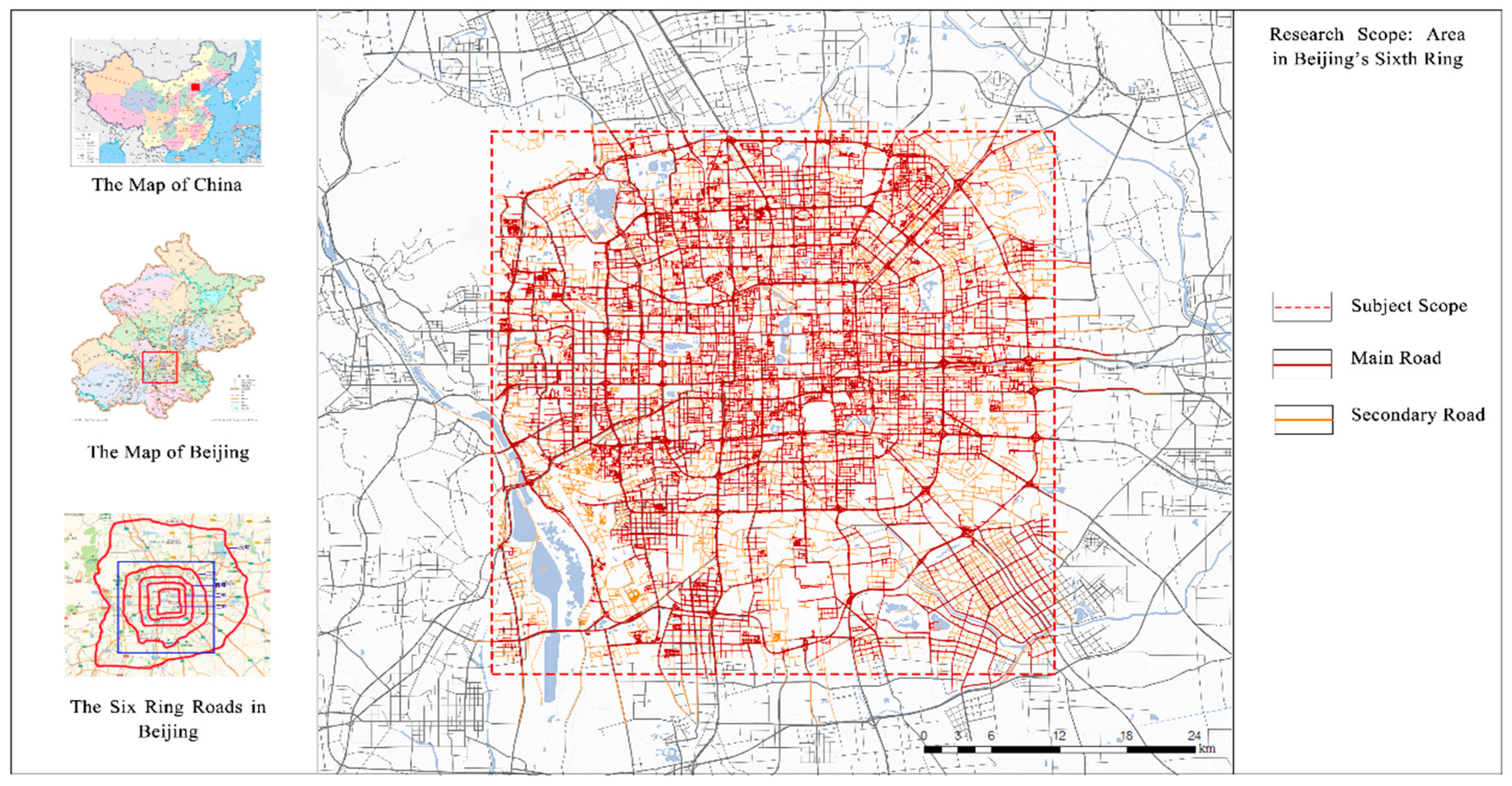
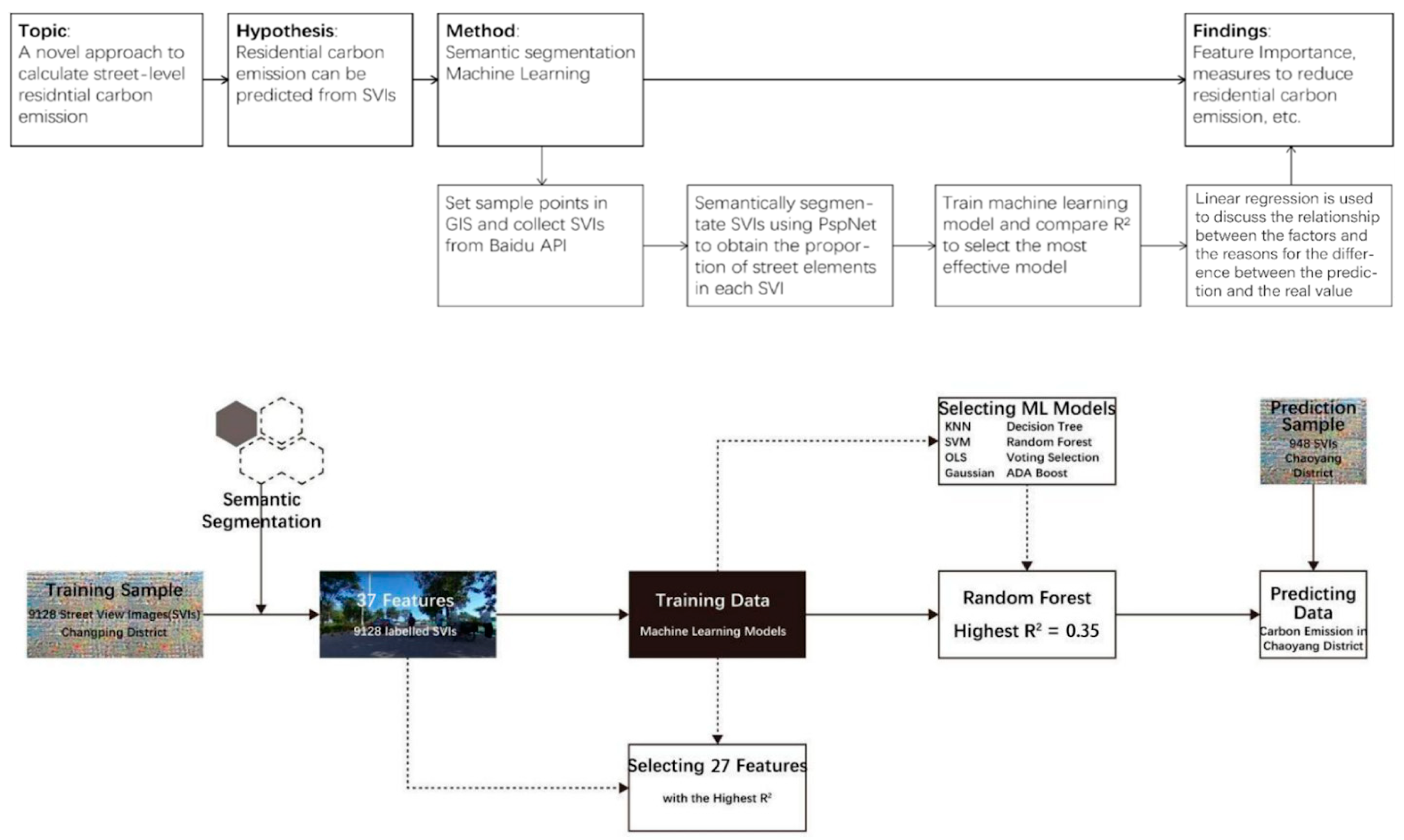
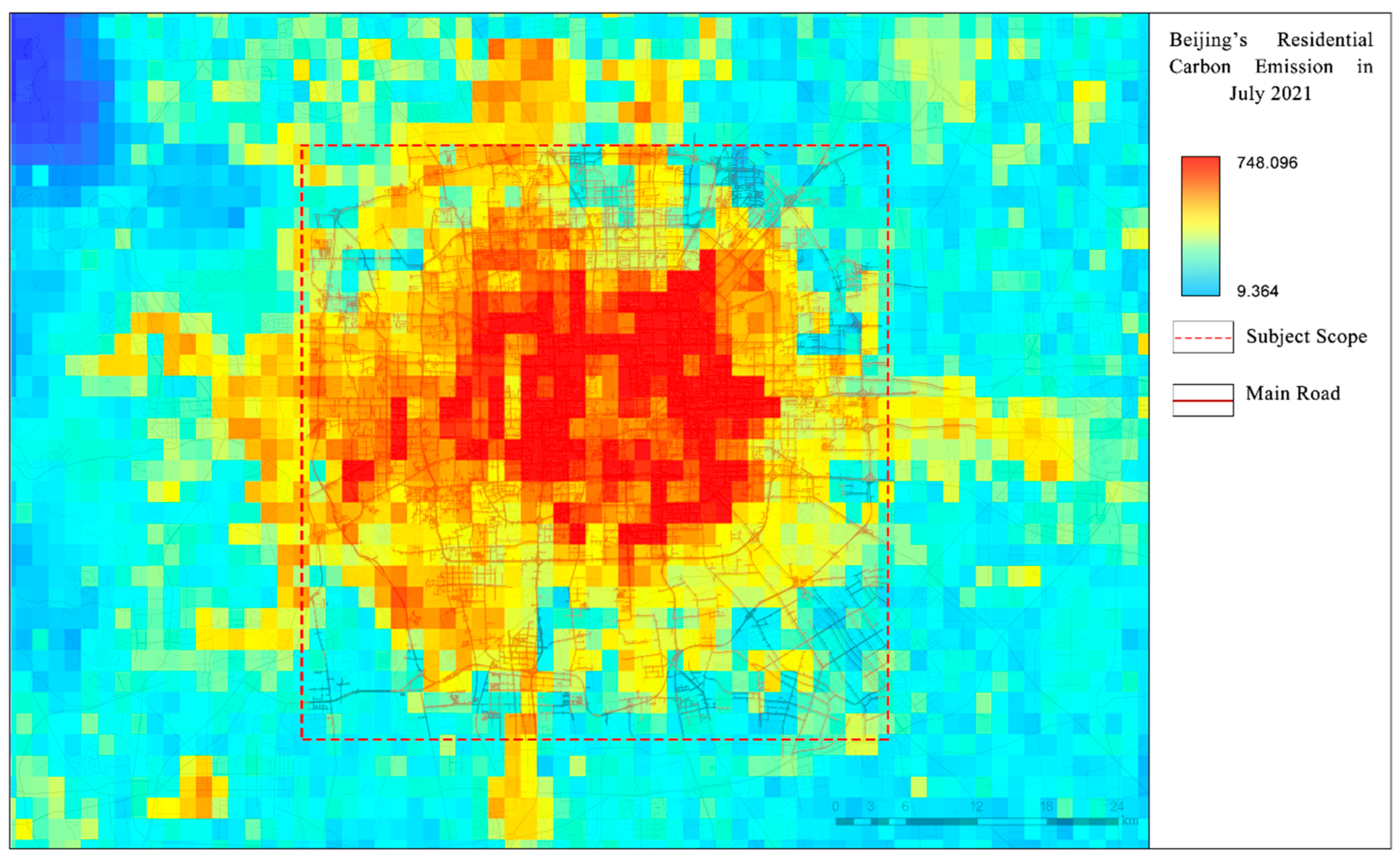
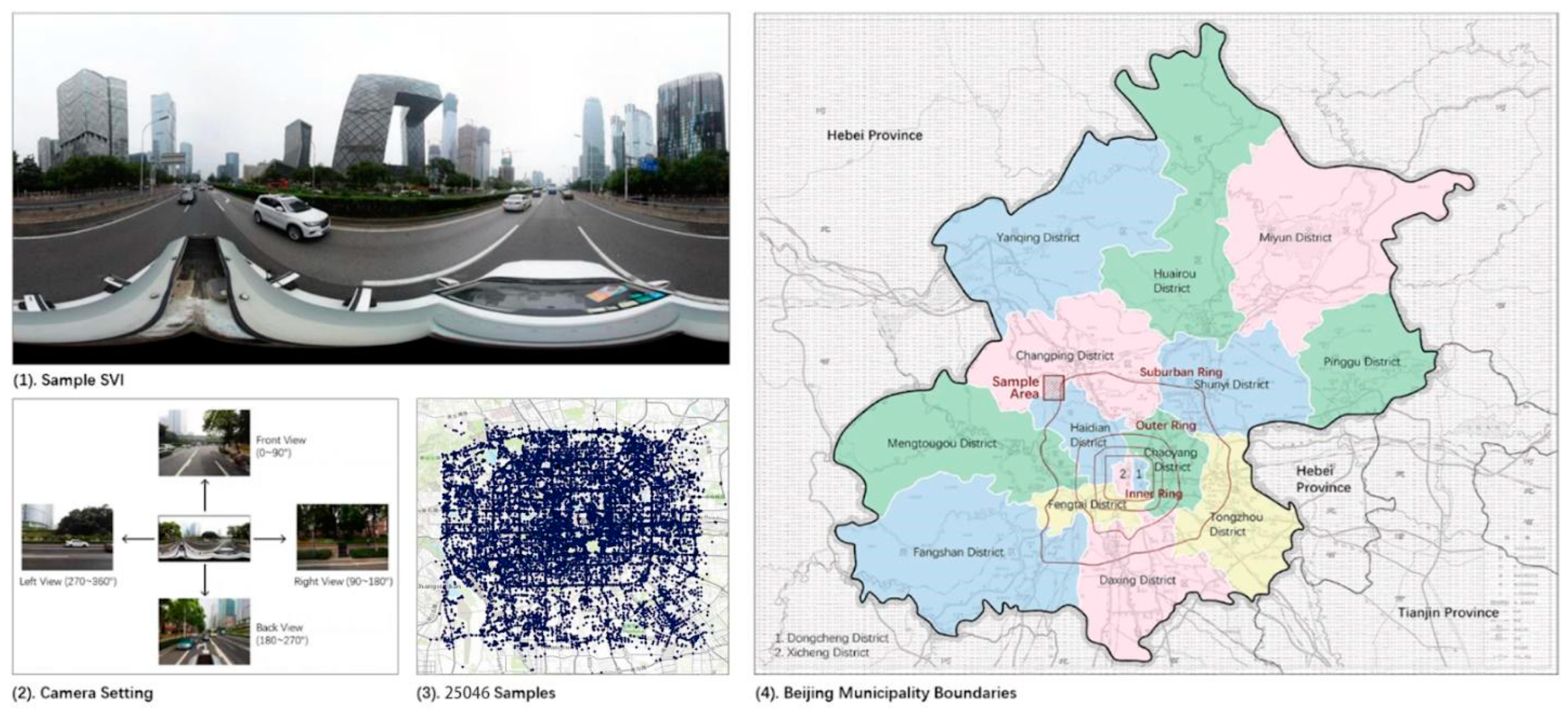

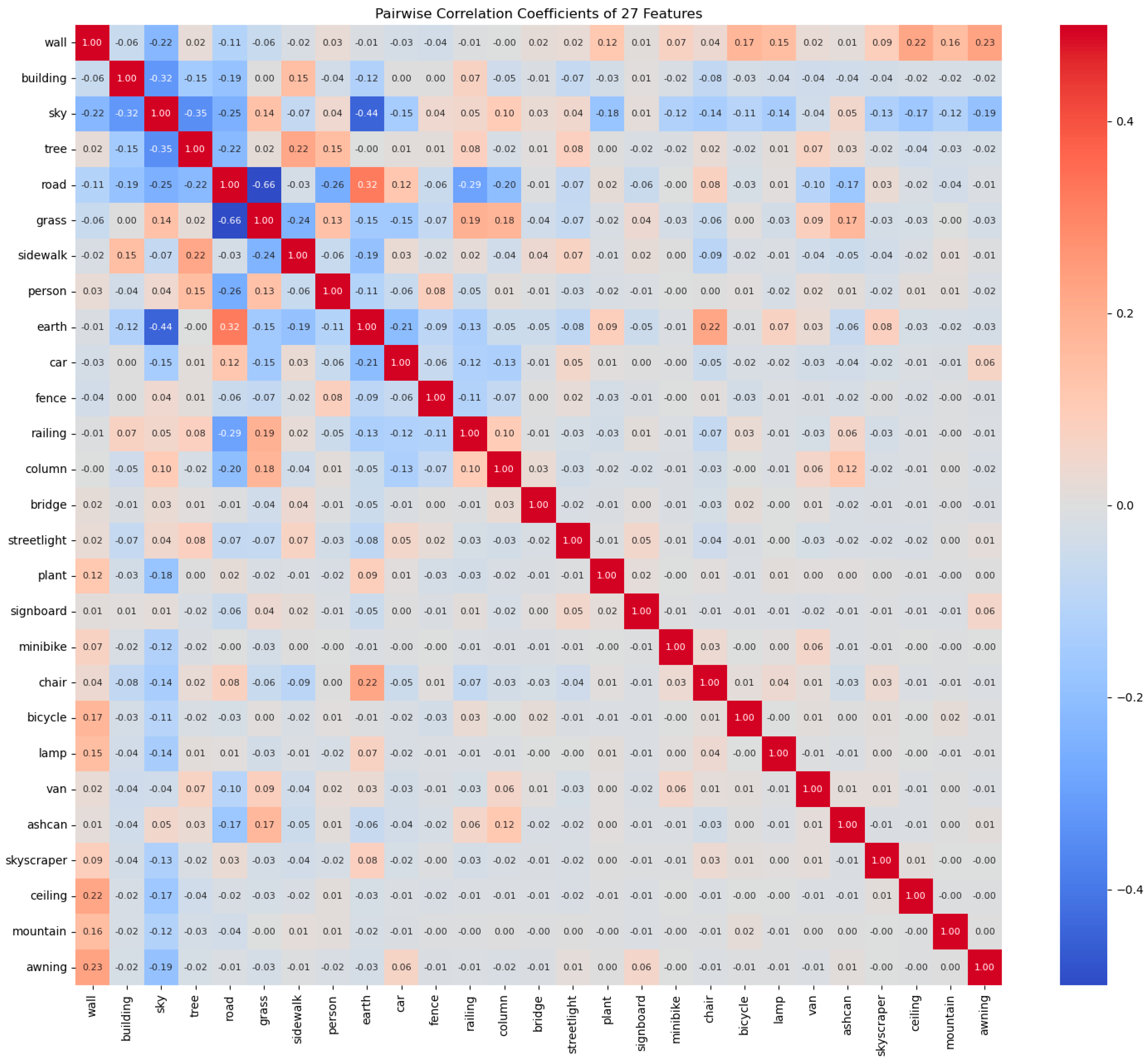
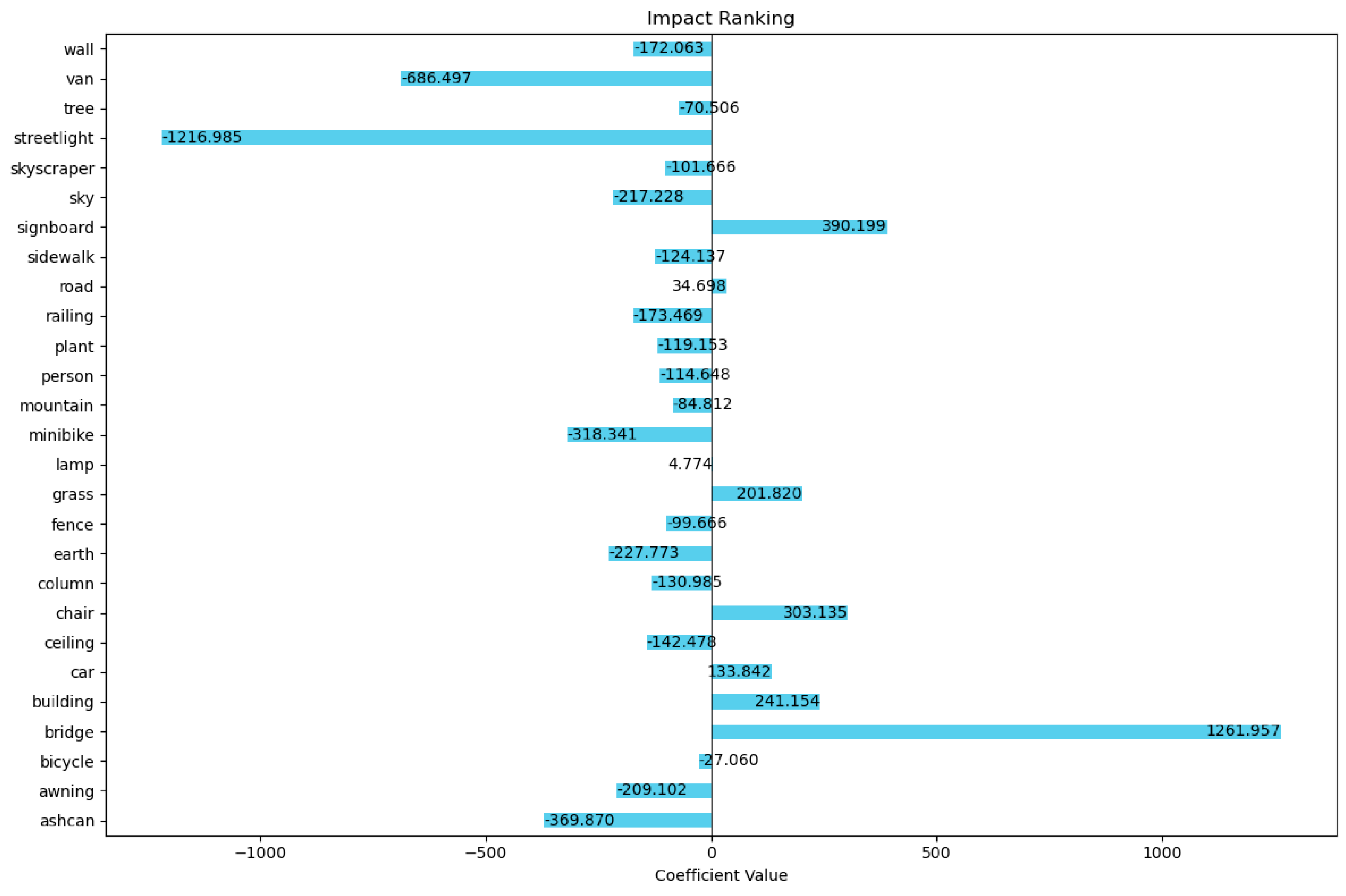
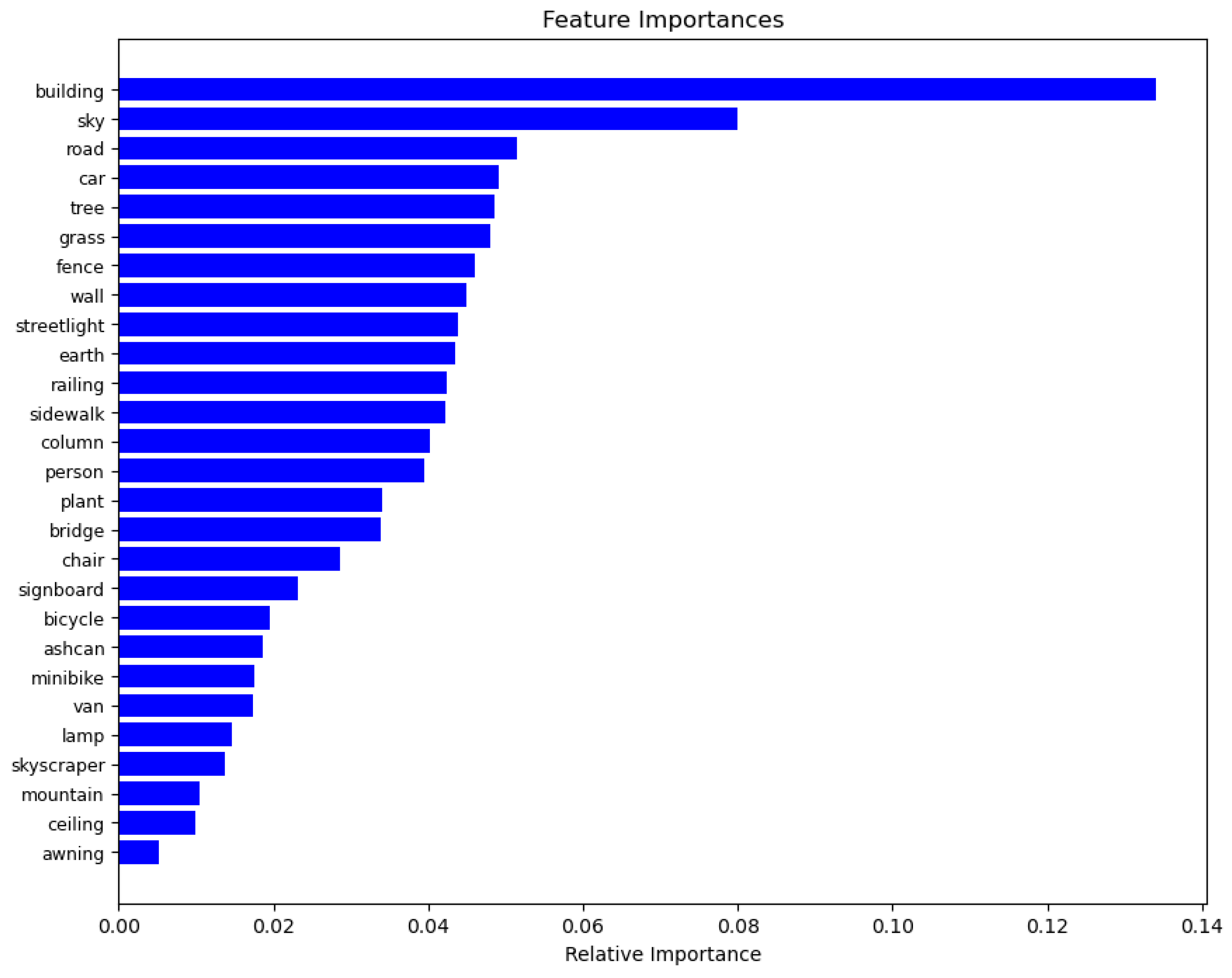
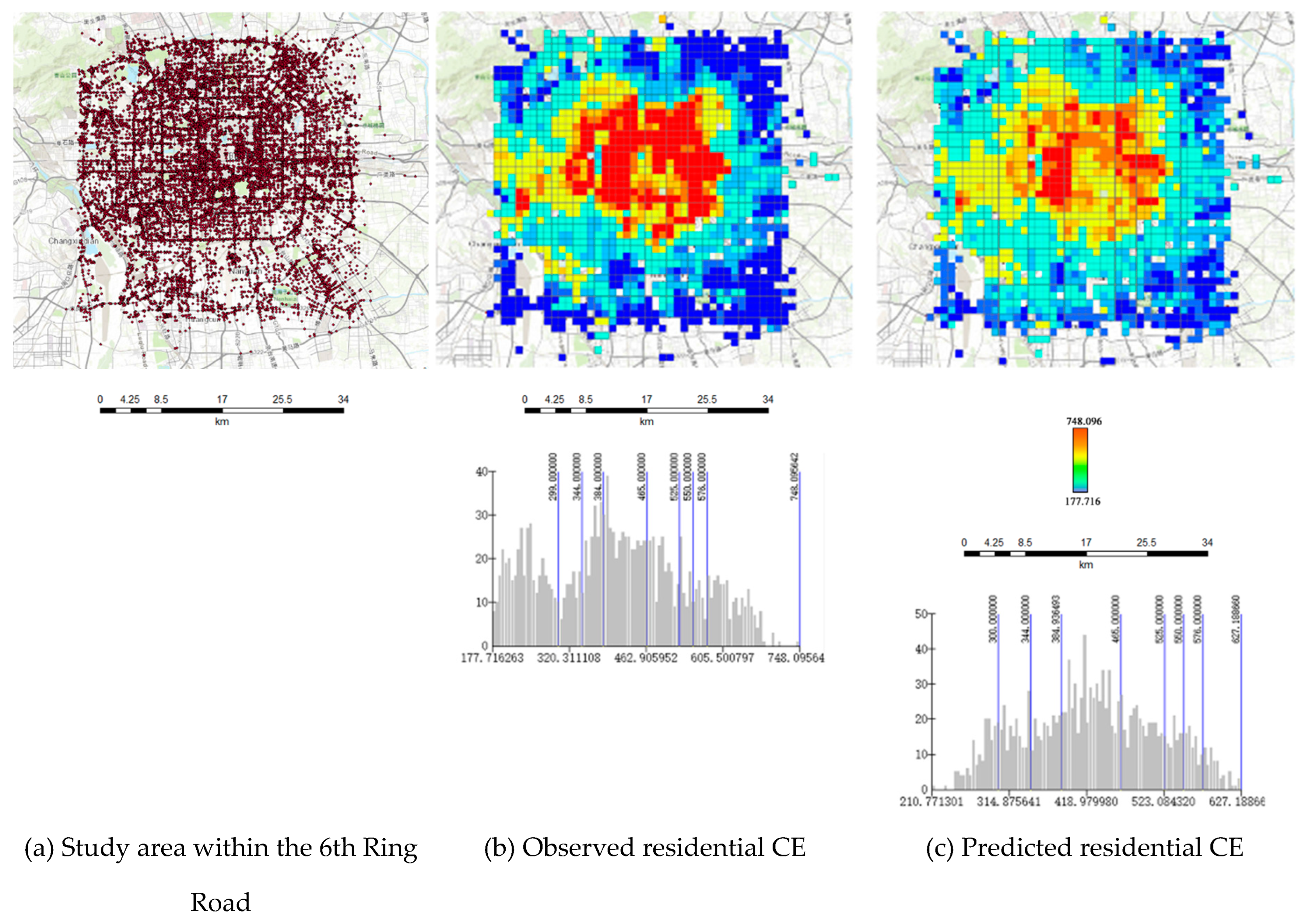
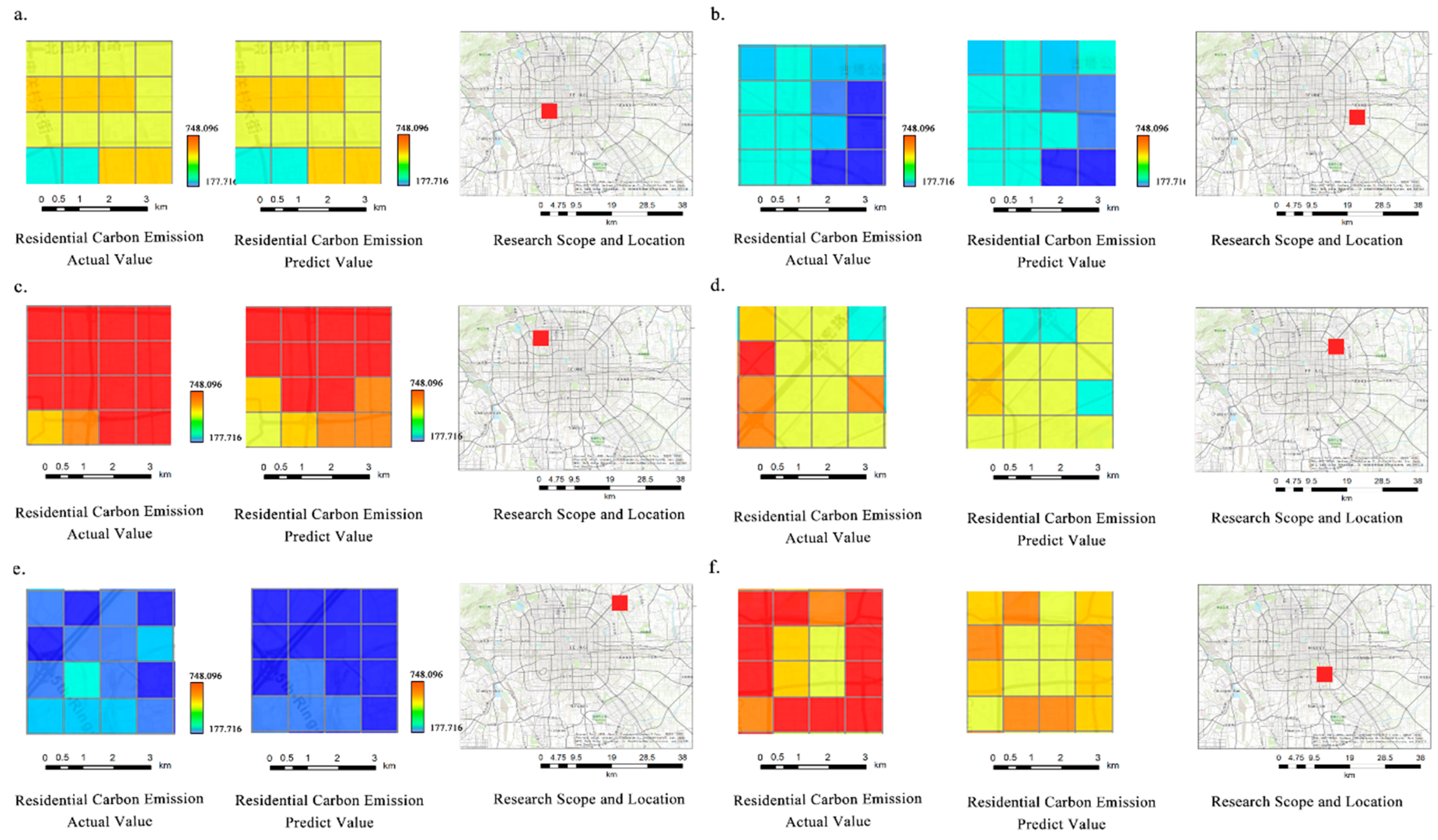
| Index | Model | R2 | RMSE (t/km2/months) | MAE (t/km2/months) |
|---|---|---|---|---|
| 1 | KNN | 0.35 | 105.17 | 83.21 |
| 2 | SVM | 0.1 | 123.31 | 100.61 |
| 3 | Random Forest* | 0.80 | 58.11 | 40.90 |
| 4 | Decision Tree | 0.74 | 66.79 | 21.69 |
| 5 | OLS | 0.1 | 123.04 | 100.22 |
| 6 | Gaussian | 0.0 | 130.72 | 106.64 |
| 7 | Voting Selection | 0.47 | 95 | 77.11 |
| 8 | Gradient Boosting | 0.23 | 113.97 | 93 |
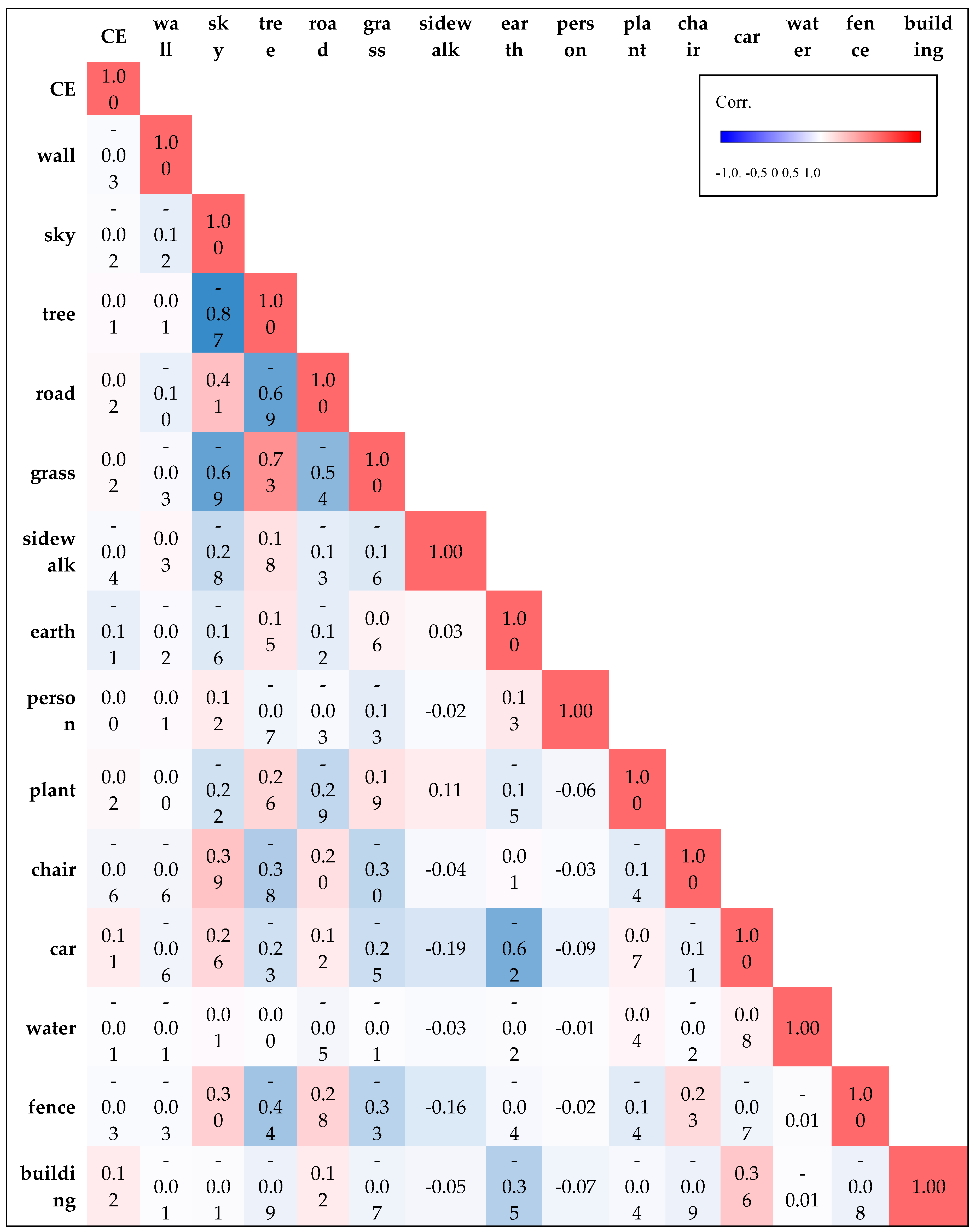
| Literature | Dep. Variable | Independent Var. | Model Performance | ||||
|---|---|---|---|---|---|---|---|
| NO. of Data Sources | Type of Variables | S.D. | MAE | RMSE | R2 | ||
| Jiang et al., 2022 | Household travel CE in Guangzhou (kg/week) | 5 | Socio-economic, household, land use, street forms, location | 5.7 | 12.7 | N/A | 0.418 (pseudo R2) |
| Zhang, Xiong and Song, 2022 | China’s annual CE (mt/year) | 6 | Forest coverage, total energy consumption, energy consumption intensity, GDP, industrial structure, employment structure | 2850.1 | 405.5 | 525.2 | N/A |
| Zhou, Zhang and Hu, 2021 | CE in China | 6 | Renewable energy development, market demand changes, energy industry regulations, industrial structure reforms, industrial technology innovation, and accidental events. | N/A | N/A | N/A | 0.74-0.77 |
|
This paper |
Residential CE (t/km2/month) | 1 | SVIs | 131.12 | 40.9 | 58.11 | 0.8 |
Disclaimer/Publisher’s Note: The statements, opinions and data contained in all publications are solely those of the individual author(s) and contributor(s) and not of MDPI and/or the editor(s). MDPI and/or the editor(s) disclaim responsibility for any injury to people or property resulting from any ideas, methods, instructions or products referred to in the content. |
© 2024 by the authors. Licensee MDPI, Basel, Switzerland. This article is an open access article distributed under the terms and conditions of the Creative Commons Attribution (CC BY) license (http://creativecommons.org/licenses/by/4.0/).




